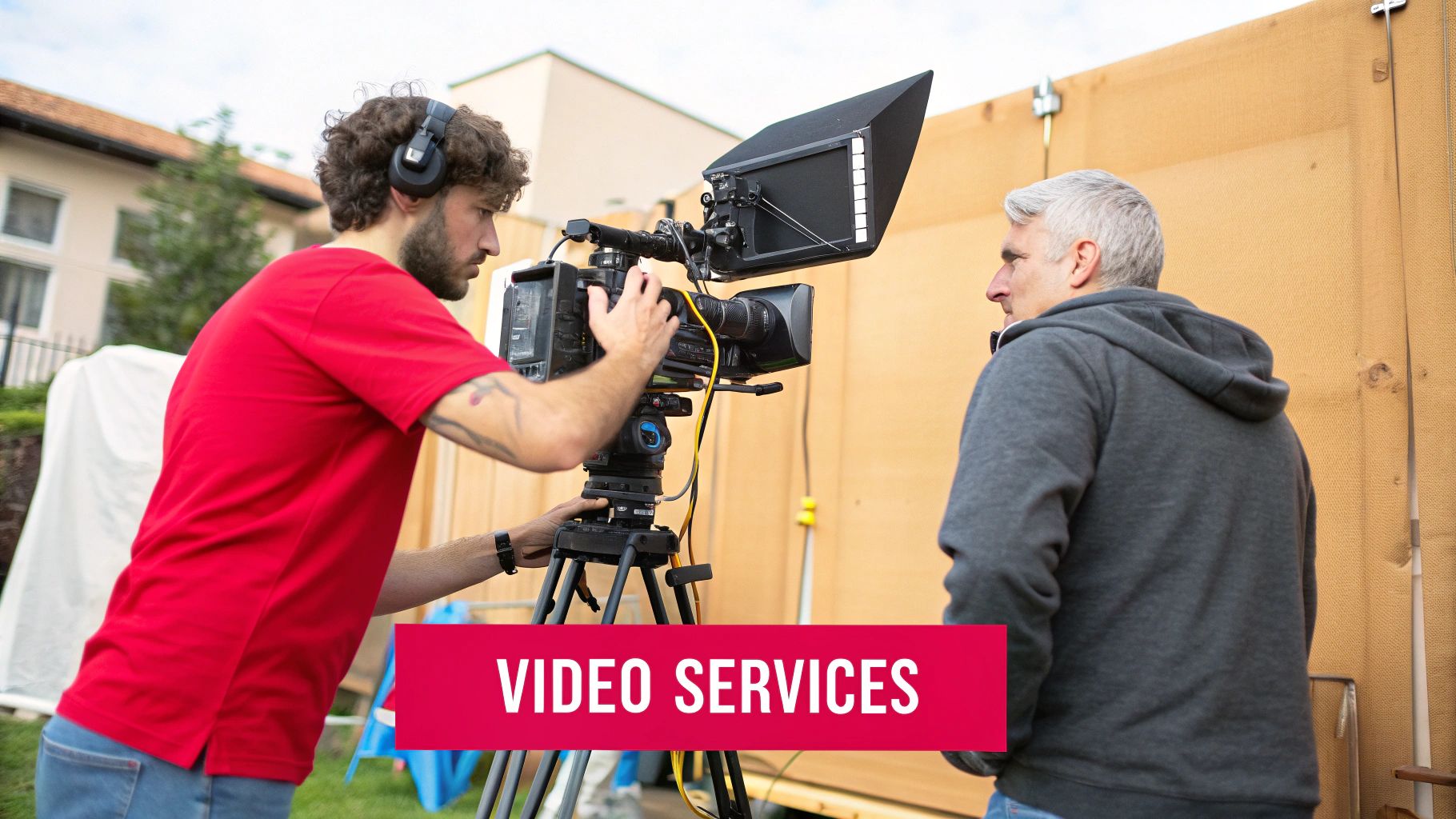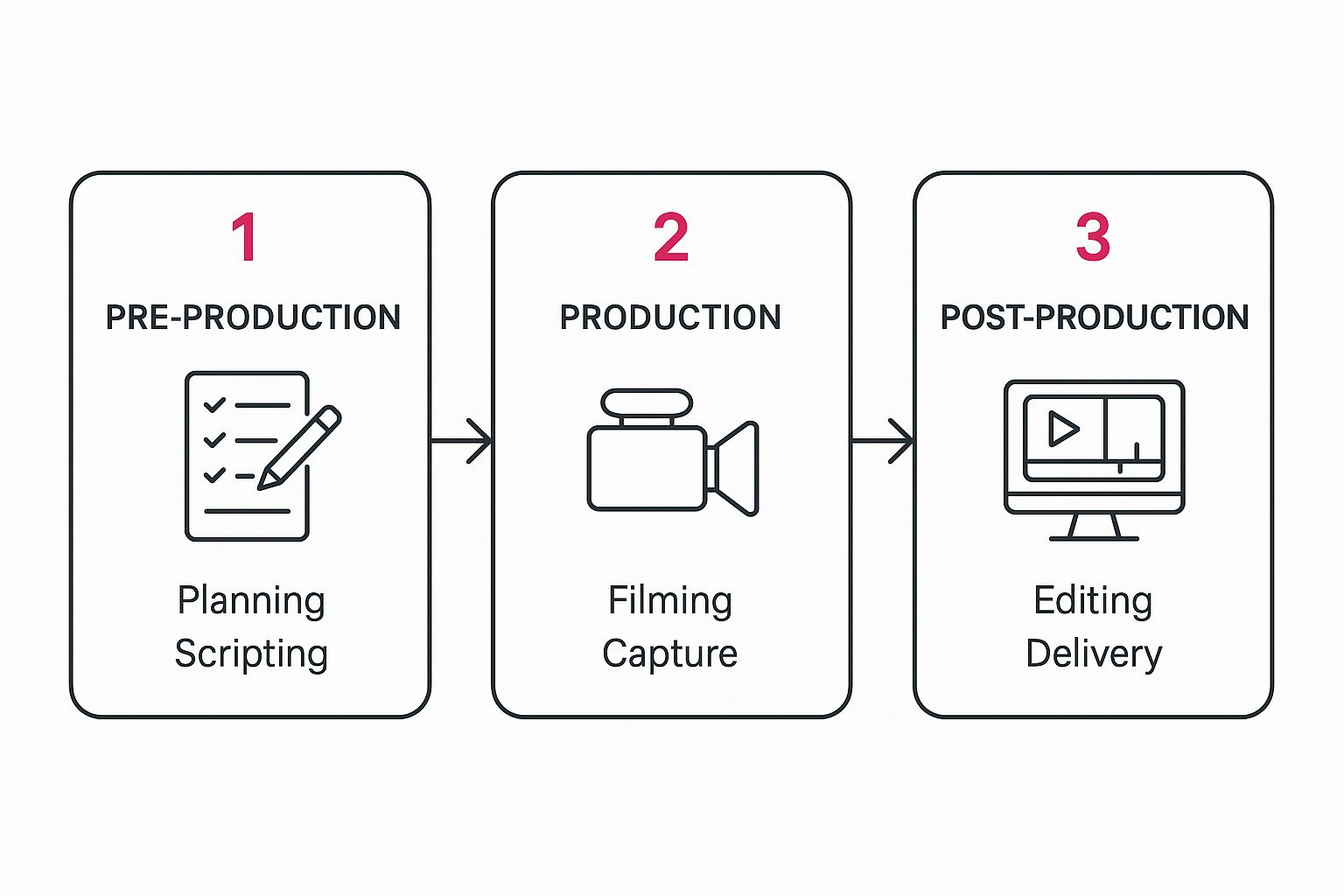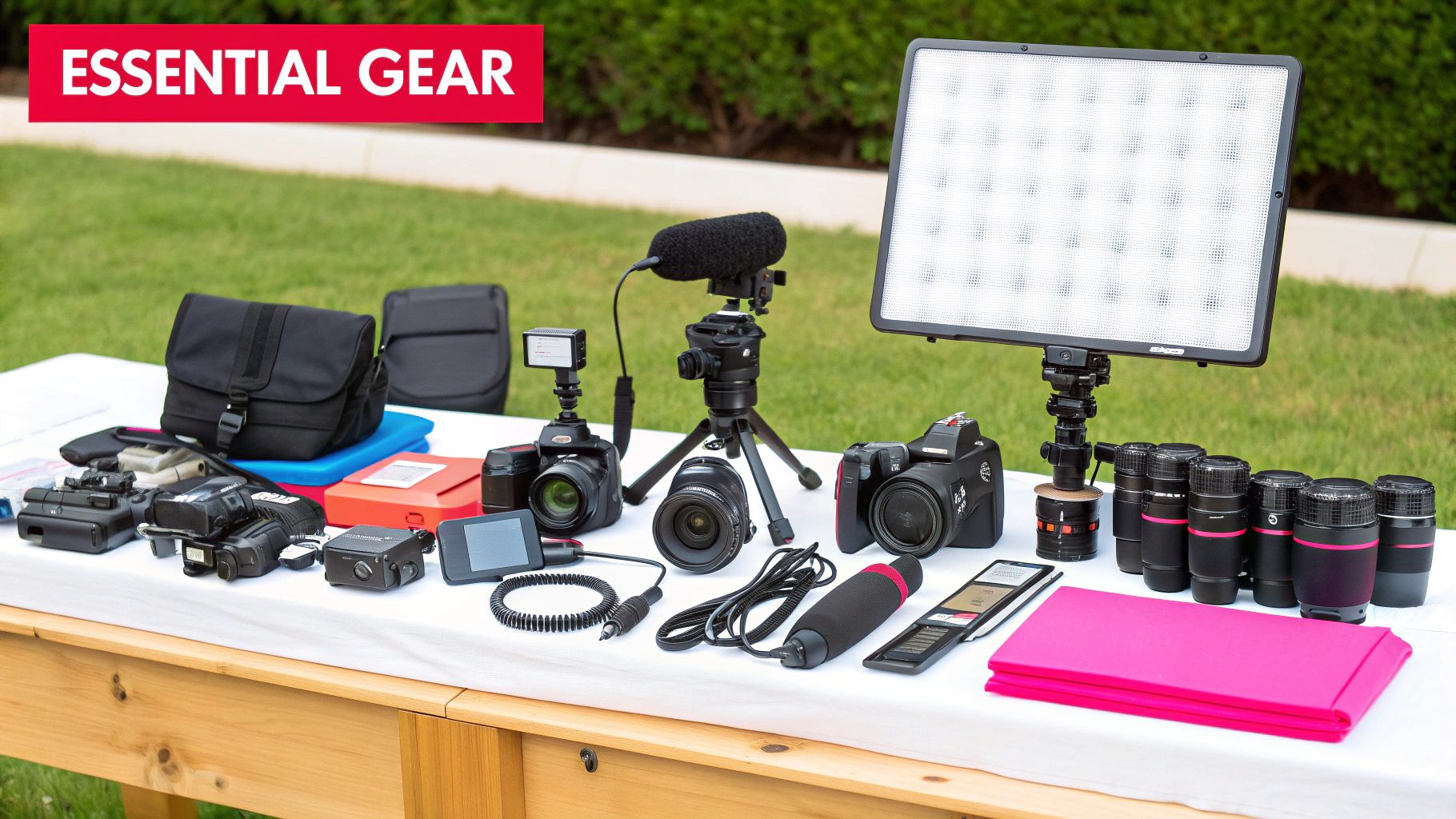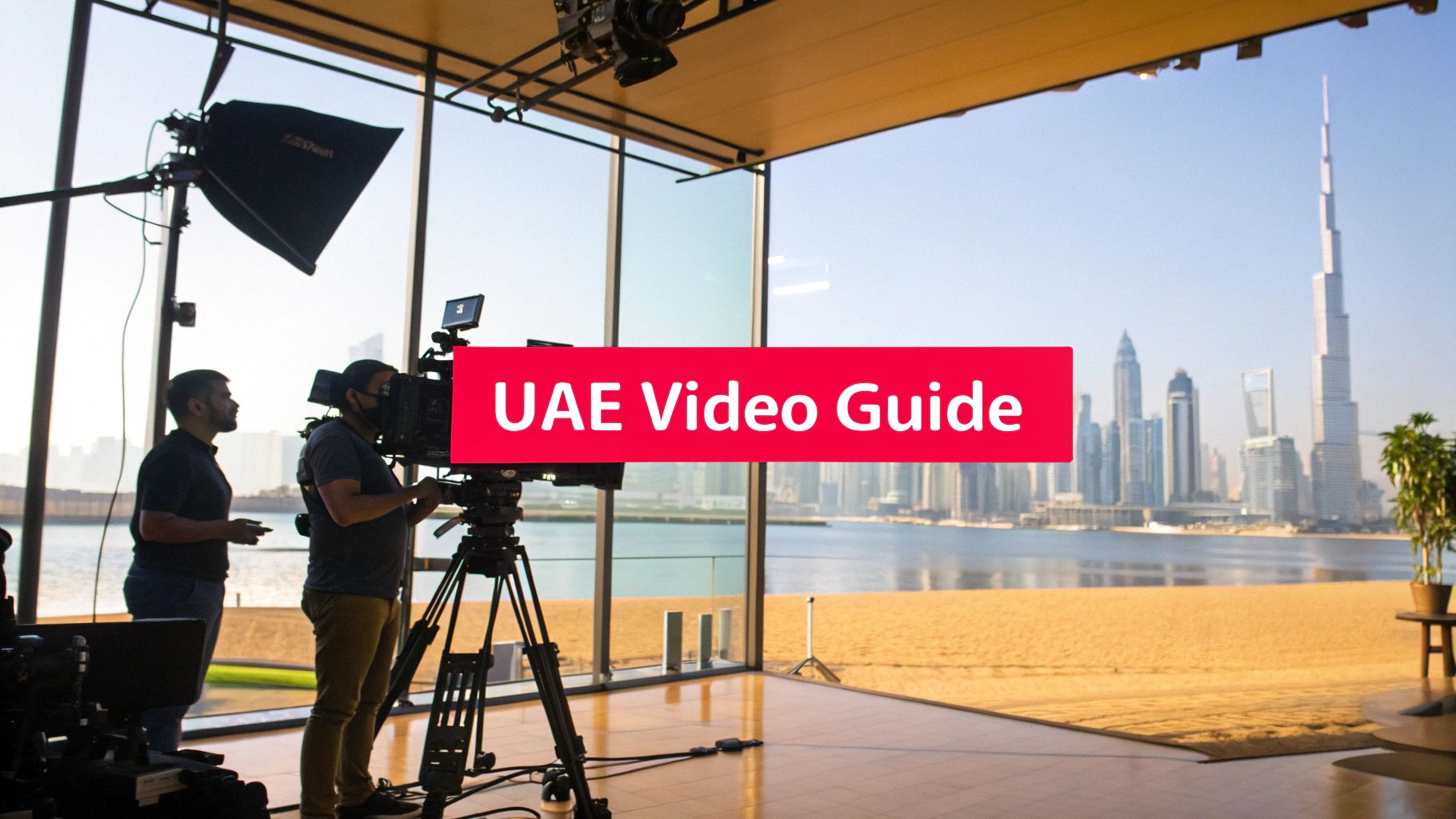So, what exactly are video production services? Put simply, they cover every single professional step involved in creating a video. This journey starts with a spark of an idea and a script, moves through filming and editing, and ends with the finished video ready for the world. It’s a complete package, handling everything from corporate videos and commercials to snappy social media content, all brought to life by a team of creative and technical pros.
What Modern Video Production Services Truly Mean

It helps to think of a video production company less like a camera crew for hire and more like an architectural firm for your brand’s story. They are strategic partners. They design the blueprint (strategy and script), they manage the construction (filming and directing), and they handle the interior design (editing, sound, and visual effects). The result is a purpose-built space where your message can truly connect with its audience.
Today’s video production services go way beyond just hitting the record button. They’re a sophisticated mix of art, technology, and marketing savvy, all working together to hit very specific business goals.
Beyond The Lens: A Strategic Approach
The real work of any professional video service starts long before a single piece of equipment is unpacked. This is the strategic planning phase, where we nail down the "why" behind your video. A great production team sits down with you to get to the heart of:
- Your Target Audience: Who are we talking to? Getting inside their heads—understanding their needs, what catches their eye, and how they watch content—is absolutely essential.
- Your Core Message: If the viewer remembers only one thing, what should it be? We have to distill your message down to its most powerful, clearest form.
- Your Desired Outcome: What do you want people to do after watching? This could be anything from visiting your website and signing up for a newsletter to making a purchase right then and there.
Getting this strategic foundation right is what separates a pretty video from an effective one. It’s the difference between just making content and making content that actually delivers results you can measure.
The Growing Importance In The UAE Market
In a fast-paced, visually hungry market like the UAE, professional video isn't a "nice-to-have" anymore—it's a critical part of how successful businesses communicate. The demand for high-quality, engaging video has skyrocketed.
The numbers tell the story. The video production market in the Middle East and Africa (MEA) region hit around USD 8.7 billion in 2023. And it’s not slowing down. Experts predict it will grow at a Compound Annual Growth Rate (CAGR) of 35.8% from 2024 to 2030.
This explosive growth points to a massive shift in how people consume information. Audiences today don't just prefer polished, compelling video from brands; they expect it. The power of a high-quality cinematic HD video is its ability to make a brand stand out in an incredibly crowded digital world. It captures attention, builds trust, and tells a story with professionalism. When you hire a video production service, you’re investing in exactly that expertise.
From Idea to Impact: The 3 Stages of Video Production
Every video you've ever loved, from a quick 30-second social media clip to a sprawling documentary, didn't just happen by accident. It followed a well-trodden path from a spark of an idea to the finished product you see on your screen. This isn't some chaotic, artistic frenzy; it's a structured, methodical process broken down into three distinct stages.
Think of it like building a house. You don't just start laying bricks and hope for the best. You need a detailed blueprint, the actual construction phase, and then the final finishing touches. Professional video production services operate on this same logical foundation to ensure everything runs smoothly, creatively, and on budget.
This process ensures that each step builds on the success of the last.

As you can see, a solid plan in the beginning is what makes the filming and editing stages truly shine.
Stage 1: Pre-Production – The Blueprint
This is where the magic really begins, long before a camera is even turned on. Pre-production is the all-important planning phase, the time to strategise and map out every single detail of the project. It's the architectural blueprint for your video.
Cutting corners here is a one-way ticket to a chaotic shoot, budget blowouts, and a final product that just doesn't connect. A solid pre-production plan makes everything that follows smoother, more efficient, and far more creative.
During this stage, the team is busy with:
- Concept and Strategy: Nailing down the "why" behind the video. Who is it for? What should they feel or do after watching?
- Scriptwriting: Putting the story to paper, crafting the dialogue, and shaping the narrative arc.
- Storyboarding & Shot Lists: Creating a visual guide, almost like a comic book, that shows exactly how each scene will look.
- Casting & Location Scouting: Finding the perfect faces to tell the story and the ideal backdrop to set the scene.
- Logistics & Scheduling: The puzzle-solving part – getting the right crew, gear, and talent to the right place at the right time.
A thorough pre-production phase is responsible for over 50% of a project's success. It’s where you solve problems on paper, not on an expensive film set.
Stage 2: Production – The Shoot
With a rock-solid plan in hand, it's time for "lights, camera, action!" The production stage is where the vision starts to become a reality. This is when the crew gathers all the raw ingredients—the footage, the sound, the performances—that will be pieced together later.
The director leads the charge, guiding the entire team to capture everything mapped out in the storyboards. It's a flurry of focused activity:
- Directing actors and guiding the crew
- Setting up cameras, lights, and microphones
- Recording crystal-clear audio
- Capturing B-roll (the extra shots that add texture and depth)
This stage is a dynamic dance of collaboration. A skilled crew knows how to think on their feet and handle unexpected challenges, all while staying true to the creative vision established back in pre-production.
Stage 3: Post-Production – The Final Polish
Once all the filming is done, the project heads to the edit suite. This is the post-production stage, where all the raw footage and audio are meticulously assembled, refined, and polished into a compelling story. If the shoot was about gathering the ingredients, post-production is where the chef works their magic to create the final, delicious meal.
This final phase is a detail-oriented process with several crucial steps:
- Video Editing: The editor sifts through all the takes, selecting the very best moments and weaving them together to create rhythm and pace.
- Sound Design & Mixing: Audio is cleaned, sound effects are layered in, and music is added to create an emotional, immersive experience.
- Colour Grading: The video's mood and visual tone are perfected by adjusting colours, contrast, and light.
- Visual Effects (VFX) & Motion Graphics: Titles, animations, and any special effects are added to elevate the narrative.
- Final Export: The finished masterpiece is exported in all the right formats for its journey to the world—whether on social media, a website, or TV.
The table below breaks down these stages and what happens in each.
Breakdown of Video Production Stages and Key Activities
| Production Stage | Core Objective | Key Activities |
|---|---|---|
| Pre-Production | To create a detailed and strategic plan for the entire project. | Concept development, scriptwriting, storyboarding, casting, location scouting, scheduling. |
| Production | To capture all necessary video and audio assets according to the plan. | Filming scenes, directing talent, recording audio, capturing B-roll footage. |
| Post-Production | To assemble, edit, and enhance the raw footage into a polished final video. | Video editing, sound design, colour grading, adding graphics, final exporting and delivery. |
Each stage is essential for creating a video that not only looks great but also achieves its goals.
In post-production, having the right tools for the job is essential; specialised drone video editing software, for instance, can make a world of difference for aerial shots. Finally, getting the video seen is the ultimate goal. For businesses here in the UAE, this often means pairing the final video with expert social media management in Dubai to ensure it reaches the right audience on the right platforms.
What Kinds of Video Production Services Are Out There?

Deciding to use video is a smart move, but "video" isn't a one-size-fits-all solution. It's more like a creative toolbox filled with different instruments for different jobs. The world of video production services is incredibly varied, with each type of video built to hit a specific business target, whether that's firing up your internal team or grabbing the attention of the wider market.
Getting a handle on this spectrum is the first step to making your investment count. After all, you wouldn't use a sledgehammer to hang a picture frame. In the same way, you wouldn’t produce a feature-length documentary to announce a weekend sale. Nailing the right format for your goal is half the battle.
Let’s break down some of the most popular and effective types of video content you’ll come across.
Corporate Videos: Building Your Brand from the Inside Out
Think of corporate videos as the backbone of business communication. They serve a huge range of needs, both for your team and for the outside world. They’re absolutely essential for shaping company culture, getting new hires settled in, and making sure stakeholders are all on the same page.
But these aren't just stuffy, formal addresses from the CEO. They can be so much more:
- Training and Onboarding: Dynamic videos that bring new team members up to speed far more effectively than a dusty old manual ever could. This is how you ensure everyone gets the same high-quality training.
- Brand Story Videos: This is where you share your "why." It’s a chance to communicate your mission, vision, and values to forge a real connection with both employees and customers.
- Internal Communications: From quarterly business updates to big announcements, video makes key information stick. It’s far more engaging and memorable for your team.
A well-made corporate video really does strengthen your brand from its core, helping to create a unified and motivated team who know exactly what they're working towards.
Commercials and Advertising: Making a Big Splash
When your main objective is to reach a massive audience and cement your brand in their minds, commercials are the tool for the job. Whether they’re created for TV, cinema screens, or major online platforms like YouTube, these videos are engineered for maximum impact in a very short space of time.
A truly great advert, whether on TV or online, can embed a brand in a consumer's consciousness for years. The aim is to craft a memorable, persuasive message that sparks action—be it visiting a website or seeking out your product in a store.
This is the high-gloss end of video production. It’s all about grabbing attention from the very first second and leaving a lasting, positive impression that lingers.
Social Media Content: Joining the Conversation
The explosion of platforms like Instagram, TikTok, and LinkedIn has opened up a whole new world of video. This calls for short, snappy, and platform-specific content that feels right at home in a user's feed. This isn’t about just squashing a TV ad onto a phone screen; it’s an entirely different language.
To win on social media, your video needs to be:
- Bite-sized: Made for short attention spans, often lasting just a handful of seconds.
- Authentic: It should feel like it belongs on the platform, not like a polished, hard-sell advertisement.
- Interactive: The best social content encourages likes, shares, comments, and direct participation from your audience.
These short-form videos are perfect for building a loyal community, driving daily engagement, and showing off the more human side of your brand. They’re how you stay relevant in the endlessly scrolling world of social feeds.
Animated Explainer Videos: Making the Complex Simple
What happens when your product is abstract, or your service is just plain hard to show on camera? This is where animated explainer videos come in to save the day. Animation gives you total creative freedom to break down complex ideas into simple, easy-to-follow, and visually engaging stories.
They work brilliantly on websites, landing pages, and in sales pitches because they can get a point across in 60-90 seconds—something that might otherwise take pages of dense text. By simplifying your message, you remove the barriers to understanding and help potential customers instantly see the value you’re offering. From software walkthroughs to financial products, animation has a knack for making the complicated crystal clear.
How Technology Is Reshaping Video Production
The video production world never stands still. It’s constantly being reinvented by new technology, and these aren't just minor tweaks we're talking about. These are fundamental shifts in how stories are filmed, edited, and brought to life, making what was once impossible totally achievable. In dynamic markets like Dubai and the wider MEA region, these tools are being embraced enthusiastically to create truly world-class content.
From AI that supercharges editing workflows to drones that give us a god's-eye view, technology is expanding what video production services can actually deliver. Let's dig into some of the tools that are opening up incredible new creative avenues for brands.
The Rise of AI in Post-Production
Artificial intelligence used to sound like science fiction, but now it's a real, practical tool that’s making post-production faster and smarter. Think of it as the ultimate assistant editor, one who can power through tedious tasks with pinpoint accuracy, freeing up the human team to focus on what they do best.
When AI handles the grunt work, our editors can concentrate on the heart of the story—the pacing, the emotional beats, and the overall creative vision.
Here’s where AI is already making a huge difference:
- Automated Transcription: Turning spoken words into text almost instantly. This is a lifesaver for creating subtitles and helps editors find that perfect soundbite buried in hours of footage.
- AI-Powered Editing: Smart tools can now sift through raw footage to pick out the best takes, perfectly sync audio to video, and even whip up a rough cut based on a script.
- Intelligent Colour Correction: AI algorithms can look at a scene and automatically balance the colours and lighting, ensuring a consistent, polished look from start to finish.
By taking on these time-consuming jobs, AI cuts down turnaround times dramatically. This means production houses can deliver exceptional content quicker than ever before.
New Perspectives with Drones and Virtual Studios
It’s not just post-production that's been transformed; the filming process itself looks completely different now. The two biggest game-changers? The everyday use of drones and the incredible potential of virtual production studios.
Drones, or UAVs, have made stunning aerial shots accessible to everyone. What once required a Hollywood-sized budget and a helicopter can now be achieved with a relatively small, remote-controlled device. This gives us those sweeping, cinematic views of landscapes, buildings, and live events that add a massive sense of scale and professionalism to any project.
Virtual production studios are an even bigger leap forward. Imagine a soundstage surrounded by massive, high-resolution LED screens. These screens can display any backdrop you can dream of—a bustling futuristic city, a serene desert, anything—creating a fully immersive environment for the actors. This incredible technology means no more weather delays, no more expensive location travel, and total control over every single detail of the world you’re building.
The Frontier of Synthetic and Volumetric Video
Looking just a little further ahead, even more mind-bending technologies are starting to hit the mainstream. Synthetic and volumetric video are leading the charge, offering entirely new ways to create visuals that are indistinguishable from reality.
Synthetic video is all about using AI to generate brand-new video content from scratch. This could mean creating ultra-realistic digital presenters or seamlessly altering existing footage. Its use is exploding in the MEA region. The synthetic media market, which includes this kind of AI-generated video, was valued at USD 0.69 billion in 2025 and is projected to hit USD 1.23 billion by 2030. Video is the main driver here, accounting for over 34% of the market, which points to a huge trend in AI-rendered spokespeople and CGI characters. You can explore more data on the synthetic media market on Mordor Intelligence.
Volumetric video takes things a step further by capturing a person or object in full three dimensions. This creates a completely interactive, photorealistic digital model you can view from any angle. These innovations are making complex visual effects more affordable and accessible than ever, putting powerful new creative tools in the hands of businesses everywhere.
Connecting Production with a Smart Distribution Strategy
You’ve done it. You’ve created a visually stunning, emotionally powerful video that perfectly captures your brand's story. But what happens if that masterpiece just sits on a server, unseen? The reality is, a brilliant video that never reaches an audience has zero impact on your business. This is where a smart distribution strategy becomes absolutely critical, bridging the gap between the creative work and the people you need to reach.
Top-tier video production services don't just hand you a file and call it a day. They think about distribution from the very first brainstorming session. Where your video will ultimately live—whether it's on YouTube, LinkedIn, Instagram, or even a cinema screen—drastically influences the creative choices made from start to finish.
Designing for the Destination
Thinking about the final destination from day one is the secret to creating a video that feels perfectly at home on its chosen platform. A one-size-fits-all approach is a recipe for wasted potential. The platform itself dictates key creative and technical specs that have to be locked down in pre-production.
Here’s a practical look at how the platform shapes the process:
- Aspect Ratio: A wide, cinematic 16:9 ratio looks fantastic on a YouTube channel or your website homepage. But try to post that same video to Instagram Stories, and it gets awkwardly cropped. For that, you need a vertical 9:16 format designed for mobile viewing.
- Pacing and Length: A snappy, 15-second video with rapid-fire cuts can grab attention on TikTok. In contrast, a more thoughtful, five-minute brand documentary is much better suited for your corporate website, where viewers are already engaged.
- Calls to Action (CTAs): A "Swipe Up" CTA is completely ineffective on YouTube, just as asking viewers to "Click the link in the bio" makes no sense in a TV commercial. The call to action has to feel native to the platform to work.
When production and distribution are planned in tandem, every single element has a purpose. This integrated approach ensures your video not only looks incredible but also performs brilliantly wherever it’s seen. A well-rounded digital marketing strategy for your small business will make sure this video connects with the right audience.
Tapping into the MEA Streaming Boom
Having a solid distribution plan is even more crucial here in the Middle East and Africa, where the video streaming market is absolutely exploding. This massive growth opens up a huge opportunity for businesses to connect with people through both on-demand and live content.
The numbers are staggering. In 2024 alone, video streaming pumped USD 7 billion into the MEA economy. Forecasts predict this market will skyrocket to USD 23.5 billion by 2030, showing a massive shift in how people across the region watch and engage with media.
Live video streaming is at the forefront of this wave, proving to be the largest and fastest-growing segment. This is largely driven by better internet access and the fact that everyone is watching videos on their phones. For any business, this means finding a production partner who gets how to create and share content for these platforms is key to staying relevant. You can dig deeper into these trends in the MEA's video streaming market report at Grand View Research.
At the end of the day, production and distribution aren't separate steps; they're two sides of the same coin. One creates the message, and the other makes sure it gets heard. By weaving them together from the beginning, you give your video the best possible chance to engage viewers and deliver a real return on your investment.
How to Choose the Right Video Production Partner

Finding the right video production service isn't just about picking a supplier from a list. Think of it more like finding the right architect to build your brand’s story. A true partner won't just follow instructions; they'll help you shape your vision and make sure every shot, sound, and edit aligns with your ultimate goals.
First things first, dive into their portfolio. Don't just look for pretty pictures; look for a style that resonates with your brand and, crucially, for experience in your industry. A team that has produced great work for a company like yours already understands your audience. A varied portfolio also shows they’re adaptable and can think creatively, not just stick to one formula.
Next, see what past clients are saying. Go beyond the curated testimonials on their website and look for detailed case studies. Real-world feedback tells you how they handle pressure, solve problems when things don't go to plan, and if they deliver on their promises.
It's also essential to understand how they work. Get them to talk you through their creative process, from the initial brainstorming session right through to the final sign-off. You need to know who’s steering the ship at each stage and how they handle feedback or changes.
Good communication is the glue that holds a project together. How do they manage their projects? Do they use clear, accessible tools? Prompt, transparent updates aren't just a nice-to-have; they’re a sign of a professional team that respects your time and investment.
"Collaboration thrives on clear expectations and mutual respect," notes a UAE marketing director on the importance of teamwork and trust.
Key Screening Questions
When you're vetting potential partners, a few key questions can reveal a lot.
- Can you walk me through a recent project you did for a client in my industry?
- How do you typically handle unexpected changes or challenges during production?
- What does your revision process look like, and what are the turnaround times?
These aren't just tick-box questions. Their answers will give you a real sense of their transparency, flexibility, and approach to collaboration.
Pricing is another area where you can't afford any ambiguity. Always ask for a detailed quote that breaks down the costs for pre-production, the shoot itself, and post-production. You need to know exactly what you're paying for to avoid nasty surprises down the line.
Here in the UAE, local knowledge is a massive advantage. A partner who knows the ins and outs of Dubai's permit processes and regional filming regulations can save you a world of headaches and delays. They’ll also have a network of local talent, from actors to location scouts, which can make all the difference.
Finally, trust your gut. During those initial conversations, do they seem genuinely interested in your brand and what you want to achieve? A team that asks smart, probing questions is a team that’s already invested in your success.
Final Selection Checklist
Before you make your final decision, run through this quick checklist:
- Portfolio: Does their work align with your creative vision?
- Proof: Do they have solid testimonials and case studies with measurable results?
- Process: Is their creative workflow clear and collaborative?
- Pricing: Is the cost breakdown transparent and detailed?
- Communication: Are their project management and communication styles a good fit for you?
With this framework, you can confidently compare proposals and choose a partner who will bring your vision to life.
Read also: Learn why choosing the right creative partner makes all the difference in ensuring your video investment thrives.
And if you're planning a major event, many of the same principles apply. This guide on essential questions to ask a wedding videographer can be a great resource for evaluating any kind of specialised event videography.
One last piece of advice: always set aside a contingency fund. A buffer of around 10% of the total budget gives you breathing room for any unexpected costs or creative detours. This simple step can be the difference between a stressful project and a smooth one.
Make sure you also get a detailed timeline with clear milestones. When everyone knows what's due and when, it creates a sense of shared responsibility and keeps the project moving forward. Following this simple framework will help you get reliable, impressive results every time.
Got Questions About Video Production? We’ve Got Answers.
Jumping into professional video for the first time can feel like a maze of new terms and processes. You're not alone. We get asked a lot of questions about everything from timelines to creative ownership, so let's clear up some of the most common ones right now.
How Long Does Video Production Actually Take?
This is the big one, and the honest answer is: it depends. There’s no one-size-fits-all timeline. A quick-turnaround social media clip shot in one location could be done and dusted in a week. On the other hand, a full-blown TV commercial with actors, multiple locations, and heavy visual effects could easily stretch over several months.
What really dictates the speed is the prep work. A project with a locked-in script, a clear storyboard, and a solid schedule will always run smoother and faster. As a general rule of thumb, you should probably plan for at least 4-6 weeks for a standard corporate video. This gives everyone enough breathing room for proper planning, filming, and a few rounds of edits without cutting corners on creativity.
Who Owns the Final Video and Raw Footage?
This is a critical detail you need to get straight in your contract before a single camera rolls. In almost every case, you—the client—will own the rights to the final, edited video. That means it's yours to post on your website, share on social media, and use in your ad campaigns however you see fit.
But the raw, unedited footage is a different ball game. Production companies almost always keep the ownership of those raw files. Think of it this way: when you go to a restaurant, you pay for the beautifully plated meal, not for the sack of potatoes and raw ingredients in the kitchen. If you think you might need the raw footage for other projects down the line, you absolutely need to negotiate for it upfront. It usually comes with an extra fee.
It's an industry-wide standard for the creative agency to hold onto the rights for the raw assets. Just make sure you talk this through with your production partner and have it spelled out clearly in your agreement. It’ll save everyone a headache later.
What’s B-Roll, and Why Do I Keep Hearing About It?
B-roll is all the extra footage that adds flavour and context to your story. Your main footage—the A-roll—is usually the interview, the product demo, or the main action. B-roll is everything else that helps tell that story visually.
- For a customer testimonial: The A-roll is the person talking. The B-roll would be shots of them happily using your product or service.
- For a company culture video: The B-roll might be shots of your team collaborating in the office, the vibrant workspace, or close-ups of your products being made.
Without good B-roll, videos can feel incredibly static and, frankly, a bit boring. It's the secret weapon editors use to cut away from someone talking for too long, visually explain a point they're making, and generally keep the viewer's eyes glued to the screen. Any good production crew will make it a priority to capture a ton of high-quality B-roll on shoot day.
Ready to bring your brand’s story to life with video that doesn't just look good, but actually works? The team at Grassroots Creative Agency blends smart strategy with creative passion to produce videos that deliver real results. Let's make something amazing together. Explore our services and start your project today.








